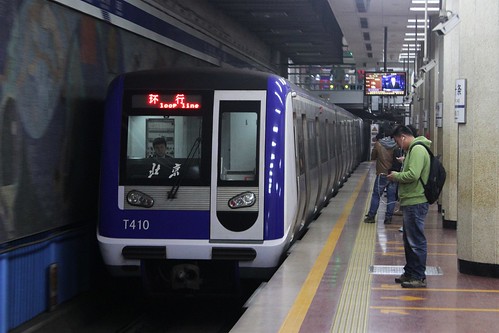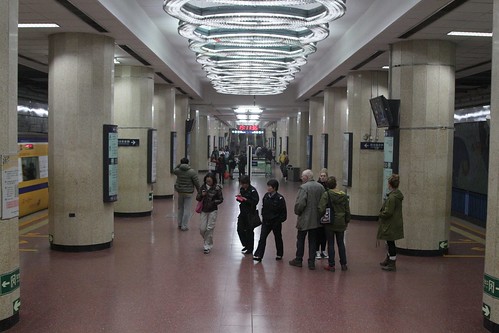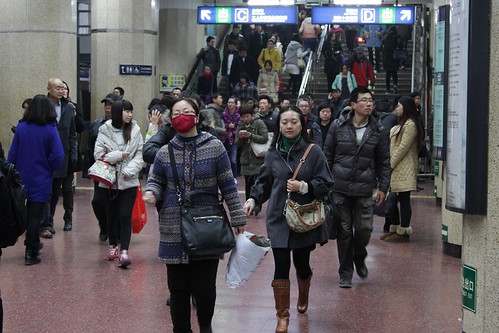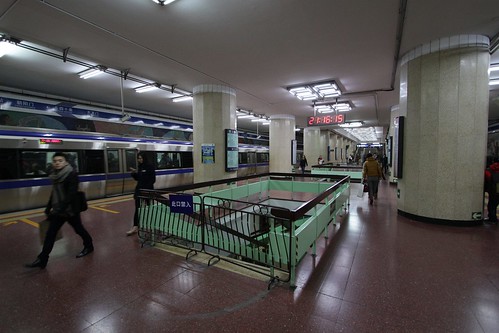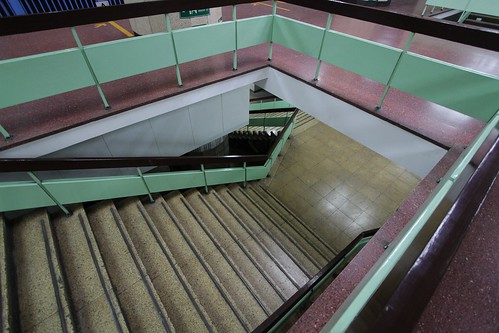During my time wandering around the Beijing Subway I found a variety of stations to exploring, but the one that had me asking questions was at Dongsishitiao on Line 2.
Going for a wander
Opened in 1984, Dongsishitiao looks much like any other station build during the early phase of subway construction in Beijing.
With an island platform.
Mosaic murals on the walls.
Stairs at the end of the platform.
Connecting to an overhead bridge.
But in the middle of the platform was something off – a set of locked up stairs.
Leading down into a basement.
So where did they lead?
A ghost platform
When I got home, Wikipedia gave me the answer – it’s a whole other platform!
Which has lay idle for years.
The lower level of Dongsishitiao Station has a reserved platform for the future Line 3. The platform was built during the construction of Dongsishitiao Station, but its use was shelved because the construction plan of Line 3 was changed many times.
Although cleaners come to clean from time to time, a layer of dust has accumulated on the platform, especially at both ends of the platform, and there are slogans such as “Eliminate the Four Harms” left over from the early days on the walls. There are only simple movable railings at the entrance and no guards, so sometimes curious passengers enter this platform.
Idle so long that it no longer meets current standards.
The platform was designed to serve 6 car trains and Type B carriages. However, when construction on Line 3 was planned to restart in 2016, it was intended to use 8 car trains and Type A cars, so the existing reserved platform cannot be used. As a result the decision was made to convert the original reserved platform to a transfer hall, and build a replacement platform deeper underground for Line 3.
The construction of Beijing Subway Line 3 is a saga in itself.
In 1973, the Beijing subway plan was expanded from “one ring and two lines” to eight lines.
At this time, the northwest section of Line 3 was similar to the original Phase III project, but it did not stop at Xizhimen, but went all the way east through Dongsishitiao and turned towards the Capital Airport. According to the plan, the Xiyi section of Line 3 and the section from Gongti to Jiuxianqiao will be constructed between 1976 and 1980, and the Xizhimen to Gongti section will be constructed between 1980 and 1985.
But no matter which section it was, it could not be constructed as scheduled. At that time, the second phase of the subway project had not yet been completed, and the planning of Line 3 had also undergone adjustments. For example, in 1983, the west end of Line 3 was extended to Xiangshan; in 1993, the northeast section of Line 3 was added to Wangjing. “The scale of the city is getting bigger and bigger, and the changes of Line 3 also took into account the needs of development at that time.” Wan Xuehong said.
In the 1990s, Line 3 was put on the agenda again. Then 1999, the Line 13 was added in the adjustment of the line network. This is the current line 13, and construction was started in 1999, and line 3 was then put down again.
After several balances, Line 3 was formally shelved during the last round of construction plans, and it did not appear in the 2007 version of the recent plan. It was not until the 2015 version of the Beijing subway plan that Line 3 reappeared.
But Line 3 will eventually open in 2023, almost 40 years after the station for Line 2 opened.
And reserved platforms elsewhere on Line 2
The construction of Beijing Metro Line 2 Phase II saw six out of the 12 new stations provided with reserved platforms for interchange with future lines.
- Fuxingmen Station: transfer platform with the west section of Line 1, opened on 28 December 1987.
- Jianguomen Station: transfer platform with east section of Line 1, opened 28 September 1999.
- Xizhimen Station: transfer platform with proposed Line 3, opened as Line 4 on 28 September 2009.
- Jishuitan Station: transfer passage with proposed Line 4, opened as transfer to Line 19 on 31 December 2021.
- Yonghegong (Lama Temple) Station: transfer platform with Line 5, opened on 7 October 2007 as a staggered island platform, using one reserved track alongside a widened island platform.
And the sixth one – Dongsishitiao.
Footnote: carriage sizes
Metro trains in China are built to two major standards – 3.0 meter wide Type A trains, and 2.8 meter wide Type B trains.
Further reading
- Exploring the ghost station – Dongsishitiao Station photo essay by Li Rui
- More ghost stations: Beijing Subway restricted stations at Wikipedia

